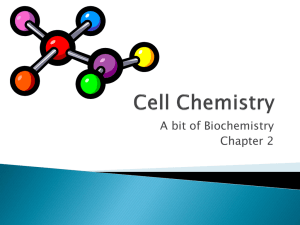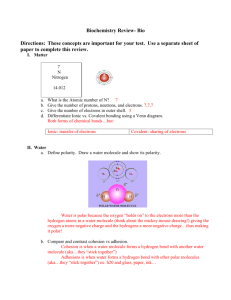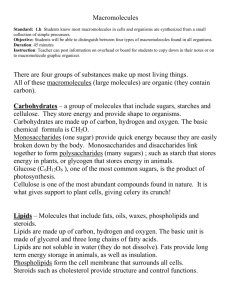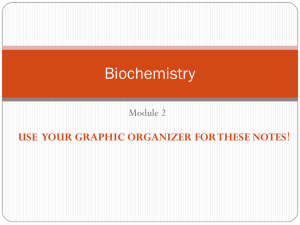Unit 2, Module 2 Biochemistry - rev 2012
advertisement
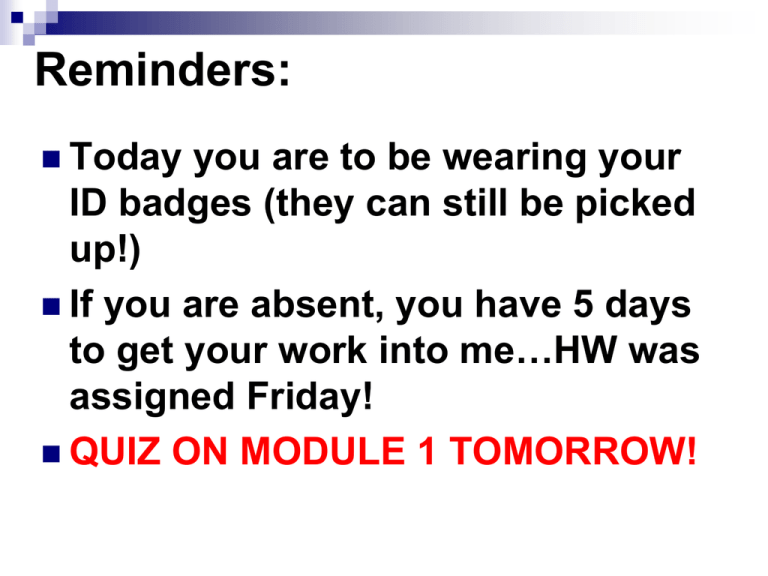
Reminders: Today you are to be wearing your ID badges (they can still be picked up!) If you are absent, you have 5 days to get your work into me…HW was assigned Friday! QUIZ ON MODULE 1 TOMORROW! Progress Check 2/4 1. The dependent variable of the plant-bulb experiment (your answer to #4) 2. Water temperature that caused the lowest rate of respiration (your answer to #15) 3. Difference in the number of seeds germinated between days 10 and 15 at 10°C (your answer to #17) 4. STERNGRR life process described in #33. Agenda 2/4 Review variables pH demonstration Reading Biochemistry notes Molecules sheets Review: Mr. Cudi noticed his jeans aren’t as clean as they used to be. He called his mom, who told him to try Clean-O Detergent. So he washed one pair of jeans with the old soap and one pair in the new Clean-O soap. After washing three times, he noticed that both jeans were equally clean. CONTROL: INDEPENDENT: DEPENDENT: Nicki notices that her shower is covered in a strange green slime. Her friend Mariah tells her that coconut juice will get rid of the green slime. Nicki decides to check this this out by spraying half of the shower with coconut juice. She sprays the other half of the shower with water. After 3 days of "treatment" there is no change in the appearance of the green slime on either side of the shower. CONROL: INDEPENDENT: DEPENDENT: NoStank Plus is a new brand of deodorant on the market and swears to last 50% longer than the original formula NoStank. Researchers at Men’s Health decide to try it. Tester “A” wears NoStank. Tester “B” wears NoStank Plus Tester “C” wears nothing. After 3 weeks, Tester “B” reports the least amount of sweat and smell on his clothing CONTROL: INDEPENDENT: DEPENDENT: pH Demonstration What is an ACID? • pH less than 7 • Neutralizes bases + • Forms H ions in solution • Corrosive-reacts with most metals to form hydrogen gas • Good conductors of electricity Common acids and bases Do we eat more acids or bases? What is a BASE? pH greater than 7 Feels slippery Dissolves fats and oils Usually forms OH ions in solution Neutralizes acids Acids and Bases Acids 0 Bases 7 Where can we find the strongest acids? The strongest bases? 14 Cellular Chemistry Unit 2, Module 2 Review from Monday Name an element: Where can we find elements? What makes up an element? What’s the difference between an element and a compound? I. Where can I find chemicals in my body? A. A chemical is a substance that is made up of elements/molecules and used in a chemical reaction. Chemicals made up of more than one type of element are called compounds. B. Living things are composed of two main types of chemical compounds: C 1. Inorganic: compounds that do not contain carbon, oxygen, and hydrogen. Water (made of the elements hydrogen and oxygen) is the most important inorganic compound for life: Organic vs. Inorganic? NH3 CaCl2 C6H12O6 CH4 Name the elements you see here! I. Where can I find chemicals in my body? i. Water is the most abundant compound in a cell (and organism). Most organisms are 60-90% water by weight ii. Most chemical reactions occur in water because it provides an optimum environment Ex. transport of molecules in the cell I. Where can I find chemicals in my body? 2. Organic: compounds that DO contain carbon, oxygen, and hydrogen a. Carbohydrates (carbon, hydrogen, oxygen) Ex. Provide energy source for respiration (glucose) b. Lipids (carbon, hydrogen, oxygen) Ex. Insulate and protect organs in the body (fats) Carbs Can you think of carbohydrates in your house? Burning Gummy Bear Lipids Body fat for women and men Age 20-40 yrs 41-60 yrs 61-79 yrs Age 20-40 yrs 41-60 yrs 61-79 yrs Underfat Under 8% Under 11% Under 13% Underfat Under 21% Under 23% Under 24% Healthy Range 8-19% 11-22% 13-25% Overweight 19-25% 22-27% 25-30% Healthy Range 21-33% 23-35% 24-36% Overweight 33-39% 35-40% 36-42% Obese Over 25% Over 27% Over 30% Obese Over 39% Over 40% Over 42% Liposuction – Fat suction Lipid = fat! Nucleic Acids (carbon, hydrogen, oxygen, nitrogen and phosphorus) Ex. Allow traits to be passed from parent to child (DNA) d. Proteins (carbon, hydrogen, oxygen, nitrogen, sulfur, phosphorus) Ex. Provide specifically shaped molecules that can carry other molecules (hemoglobin carries oxygen) c. Reminders: Today you are to be wearing your ID badges (they can still be picked up!) If you are absent, you have 5 days to get your work into me…HW was assigned Friday! QUIZ ON MODULE 1 TODAY! Agenda 2/5 Progress check Module notes Go over Problem Solving for Module 1 Module 1 quiz Review macromolecules Finish macromolecules activity Review from Tues. Organic vs. Inorganic? NH3 CaCl2 C6H12O6 CH4 Review: What is this? 0 7 14 Review: Name a household substance we tested yesterday that was an acid. Name a household substance we tested yesterday that was a base. What IS an acid or a base? Acids: Hydrogen donor Bases: Hydrogen acceptor H+ H+ H+ H+ OH- OHOH- H+ H+ H+ OHOH- H+ H+ OH- OHOHH+ OH- What do we mean by strong acids and bases? 0 7 pH stands for “Potential Hydrogen” 14 pH ScaleAcid: form H+ ions in a solution pH range 0-6.9 Base: Form OH- ions in a solution pH range 8-14 I. Where can I find chemicals in my body? C. Scientists can test for the presence of the different chemicals, such as carbohydrates, using indicators. For example, iodine changes to a blue-black color in the presence of starches. I. Where can I find chemicals in my body? D. The six essential elements (CHNOPS) are essential to life because they help maintain homeostasis. a. The elements make up essential organic and inorganic compounds. Each type of molecule performs specific jobs in organisms (see examples above). I. Where can I find chemicals in my body? b. Hydrogen is also donated or accepted by weak acidbase pairs to regulate the pH of a system like cells and blood. These weak acid-base pairs are called buffers. i. When a cell’s pH drops (becomes more acidic), the buffers in the cell “accept” the hydrogen ions which reverses the pH change ii. When a cell’s pH rises (becomes more basic), the buffers in the cell “donate” hydrogen ions iii. In a cell, acid is being produced as the cell respires. To maintain the pH, a cell must use buffers to counteract the acid iv. Different cells or areas of the organism need different pH levels to perform. Buffers help keep that pH level constant You make acid just by breathing! Carbonic acid! Buffer Buffers can donate hydrogen Buffers can accept hydrogen. http://chemcollective.org/activities/tutorials/buffers/buffers3 These are examples of artificial “buffers” we use Add to margins of notes! Monomer: molecule that may chemically bond to other molecules to form a large chain Polymer: large molecule (“macromolecule”) made up of repeating subunits monomer animation Build a Carb animation Build a nucelotide Proteins in your body Repair, maintenance Transport Enzymes Hormones Antibodies THURSDAY Journal 2/6 In your journal, write a reflection regarding your work and performance in Module 1. Consider the following: Did you complete all assigned work to the BEST of your ability? Were you in class every day? If you were and your grades are NOT what you want, why might this be? Do you have a good attitude about learning the material in this class? Are you keeping a positive outlook? How do you feel about your quiz grade? Does it reflect the time/effort you put in to learning this material? What IS an acid or a base? Acids: Hydrogen donor Bases: Hydrogen acceptor H+ H+ H+ H+ OH- OHOH- H+ H+ H+ OHOH- H+ H+ OH- OHOHH+ OH- 0 7 14 I. Where can I find chemicals in my body? b. Hydrogen is also donated or accepted by weak acidbase pairs to regulate the pH of a system like cells and blood. These weak acid-base pairs are called buffers. i. When a cell’s pH drops (becomes more acidic), the buffers in the cell “accept” the hydrogen ions which reverses the pH change ii. When a cell’s pH rises (becomes more basic), the buffers in the cell “donate” hydrogen ions iii. In a cell, acid is being produced as the cell respires. To maintain the pH, a cell must use buffers to counteract the acid iv. Different cells or areas of the organism need different pH levels to perform. Buffers help keep that pH level constant Buffer Demonstration Observe! Buffer Demonstration 2 1 male and 1 female volunteer You make acid just by breathing! Carbonic acid! Buffer Buffer Demonstration 3 We’re going to repeat the last demonstration, and fill out the lab on Pg. 2C [Data table and #1] Monomer: molecule that may chemically bond to other molecules to form a large chain Polymer: large molecule (“macromolecule”) made up of repeating subunits II. A. How does synthesis provide important organic macromolecules using six essential elements? Carbohydrates 1. Monosaccharides are organic compounds made of carbon, hydrogen, and oxygen in a 1:2:1 ratio. Many monosaccharides bond together forming a larger compound chain called a carbohydrate. a. In plants the monosaccharide called glucose (C6H12O6) bonds with other glucose molecules again and b. again to form starch or cellulose. The plant can use starch as food (like the “white” of a potato) and cellulose to build the stem and leaves. In animals excess glucose bond together to form a compound (similar to starch) called glycogen which is used for short-term energy storage. Glycogen is found in the liver and muscles. Burning Gummy Bear Would a marathon runner want to load up on carbs the week before the big race?? hitting the wall A sugary snack or soft drink quickly raises your blood sugar level but it's short-lived. Your pancreas starts to secrete insulin, which triggers cells in your body to pull glucose out of your bloodstream and store it for later use. Soon, the glucose available to your brain has dropped. Neurons, unable to store glucose, experience an energy crisis. Hours later, you feel spaced-out, weak, confused, and/or nervous. Your ability to focus and think suffers. The name for this glucose deficiency is hypoglycemia , and it can even lead to unconsciousness. MONOSACCHARIDE DISACCHARIDE POLYSACCHARIDE Examples: Glucose - monosaccharide -simple sugar Sucrose – disaccharide – table sugar Starch – polysaccharide - corn 2. Functions of carbohydrates Energy is released when carbohydrates are digested. This is because glucose is used for cellular respiration. a. i. ii. Monosaccharides (simple sugars) provide an immediate energy source Starch and glycogen are considered short term energy sources because these chemicals can be broken down over a period of minutes, hours or days to provide glucose for energy. b. c. Some carbohydrates are very stable and can be used for structure and support in the cell and body (cellulose in the cell wall of plant cells). Carbohydrate chains on the surface of cell membranes are used as identifiers (like name tags). How does synthesis provide important organic macromolecules using six essential elements? B. Lipids 1. There are several types of lipids, but all contain subunits of glycerol and fatty acids made of carbon, hydrogen, and oxygen. It is different from a carbohydrate because of the ratio and because the smaller units do not link together to form a chemical chain a. Fats can be saturated (usually solid at room temperature) or unsaturated (usually liquid). b. Phospholipids also contain a phosphate group and make up most of the cell membrane. c. Steroids are lipid rings and help regulate the organism through cell communication (act as hormones) Phospholipid Bilayer 2. Functions of lipids a. Because of the numerous bonds and the way the body stores lipids, they can be used as very long-term (weeks, months) energy sources. Ex. Bears accumulate a layer of fat before winter (when food will be less available) b. Fats stored in the body act as insulation and protection for internal organs. c. Some hormones are composed of lipids (steroids). Lipids Body fat for women and men Age 20-40 yrs 41-60 yrs 61-79 yrs Age 20-40 yrs 41-60 yrs 61-79 yrs Underfat Under 8% Under 11% Under 13% Underfat Under 21% Under 23% Under 24% Healthy Range 8-19% 11-22% 13-25% Overweight 19-25% 22-27% 25-30% Healthy Range 21-33% 23-35% 24-36% Overweight 33-39% 35-40% 36-42% Obese Over 25% Over 27% Over 30% Obese Over 39% Over 40% Over 42% Liposuction – Fat suction Lipid = fat! NUCLEIC ACIDS, PROTEINS Reminders: ID badges If you are absent, you have 5 days to get your work into me. If you are absent, you need to get the journal assignment from a classmate. They are also on my webpage. Progress Check 2/7 1. List the elements that can be found in a nucleic acid (found in answer #1) 2. What is your answer to #5? 3. What is your answer to #6? 4. Name the molecule with a longchain carbon backbone (answer to #2). Journal 2/7 ORGANIC COMPOUND CARBOHYDRATES LIPIDS ELEMENTS SUBUNIT (BUILDING BLOCK) IMPORTANCE/ FUNCTION Monosaccharide: glucose Dissaccharide: sucrose Polysaccharide: starch Lipid: Phospholipid Lipid: Triglyceride II. How does synthesis provide important organic macromolecules using six essential elements? C. Nucleic Acids 1. Nucleotides are compounds made up of carbon, hydrogen, oxygen, nitrogen and phosphorus. Many nucleotides bond together to make up a long chain called a nucleic acid. II. How does synthesis provide important organic macromolecules using six essential elements? 1. There are two basic types of nucleic acids: a. DNA is a double chain of nucleotides found in all living cells. b. RNA is a single chain of nucleotides that provides the structures needed for the cell to make proteins. Nucleotide structure The sugar is different in DNA and RNA DNA = Deoxyribonucleic acid RNA = Ribonucleic acid 2. Functions of nucleic acids a. DNA makes up the genes. Genes are used to pass traits from parent to offspring. Genes determine traits. b. DNA controls cellular activities by controlling the production of proteins in response to hormones and other cellular signals. c. RNA is used in the production of proteins. II. How does synthesis provide important organic macromolecules using six essential elements? D. Proteins 1. All six essential elements may be used in the production of small subunits called amino acids. There are 20 different amino acids, each with a specific side chain of chemicals. Amino acids bond to other amino acids to form a long chain called a protein. These chains of amino acids fold into a particular shape. The shape of a protein will determine its function. If a protein denatures (loses its shape) it can no longer function. II. How does synthesis provide important organic macromolecules using six essential elements? a. b. Hemoglobin is a protein shaped to hold oxygen for transport through the bloodstream. A group of proteins called enzymes are shaped to fit and react with specific molecules. Hemoglobin Binds oxygen in blood Sickle-cell anemia Inherit 2 bad copies from parents Pain, tiredness 2. Functions of proteins a. Some proteins, called pigments, absorb and reflect light. They also create color by reflecting light. Ex. Chlorophyll absorbs light to gather energy for photosynthesis, and reflects the color green b. Some proteins are constructed by cells to bind with and inactivate foreign particles in the body. These are called antibodies. c. Proteins may form structures in an organism – such as keratin (a protein) in hair and nails. Pigments Antibodies Dietary Protein 1/3 gram per pound of body weight d. e. f. Some proteins are used for transport through the cell membrane or in the bloodstream (ex. hemoglobin) Some proteins are used for communication between cells. These may be hormones (insulin) or neurotransmitters. Insulin is secreted by the pancreas and is required by the cells of the body in order for them to remove and use glucose from the blood. Insulin can be used to treat diabetes. Enzymes (a special class of protein) act to speed up chemical reactions. Insulin It causes cells in the liver, skeletal muscles, and fat tissue to absorb glucose from the blood. Enzymes Enzymes III. Why are enzymes necessary for life? Enzymes- a fun introduction - YouTube A. Enzymes help maintain homeostasis 1. 2. Metabolism (chemical reactions) requires certain conditions to occur. Enzymes regulate metabolism, allowing life to continue. Enzymes speed up reactions, making an enzyme a biological catalyst. Metabolism (each reaction) has a small range of temperature and pH at which it can proceed. Each reaction also needs some energy to begin. This is called activation energy. Enzymes allow reactions to occur at lower activation energy (body temperature). Graph of a reaction with and without an enzyme B. The structure of an enzyme determines its function 1. Enzymes are usually proteins. Proteins have a definite 3-D structure based on how the amino acid chains fold. a. b. On the enzyme, there is a place where the target molecule can attach. This place is called the active site. The target molecule/chemical is the substrate. If the enzyme’s active site changes shape too much, the substrate will not fit. An enzyme may change shape if it is denatured by a change in temperature, pH, or salinity. This means the enzyme will not be able to speed up the reaction. 2. Enzymes mediate (help) chemical reactions using a specific chemical pathway (series of steps). The enzyme collides with the substrate. b. The enzyme and substrate fit together at the active site like a lock and key. c. The enzyme changes the substrate in some way i. It may help break the substrate apart by stressing bonds. ii. It may hold two (or more) substrates together closely so the two parts interact. d. The enzyme and the substrate (now product) separate. Enzyme - YouTube a. Enzyme-Mediated Pathway C. Enzymes have distinguishing characteristics 1. 2. Enzymes are specific. This means enzymes will catalyze only one specific reaction because only certain substrates fit due to the shape of the active site. Enzymes are reusable. Notice in the diagram above that the enzyme did not change shape or split. This means it can now fit with another substrate or set of substrates and repeat its role in speeding up the reaction.

